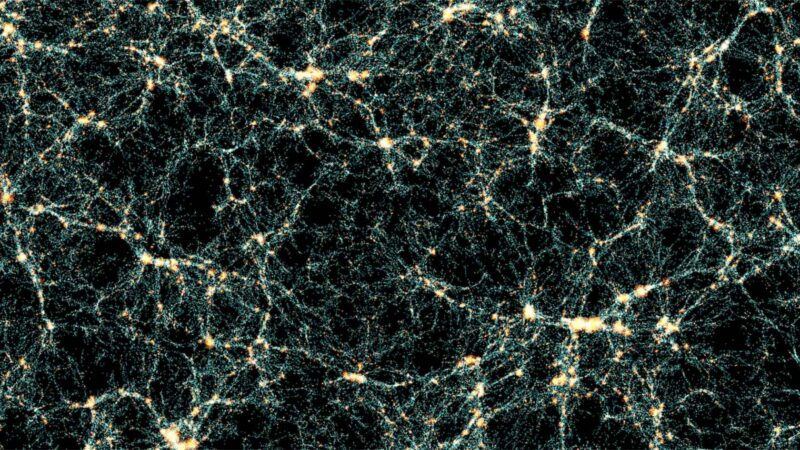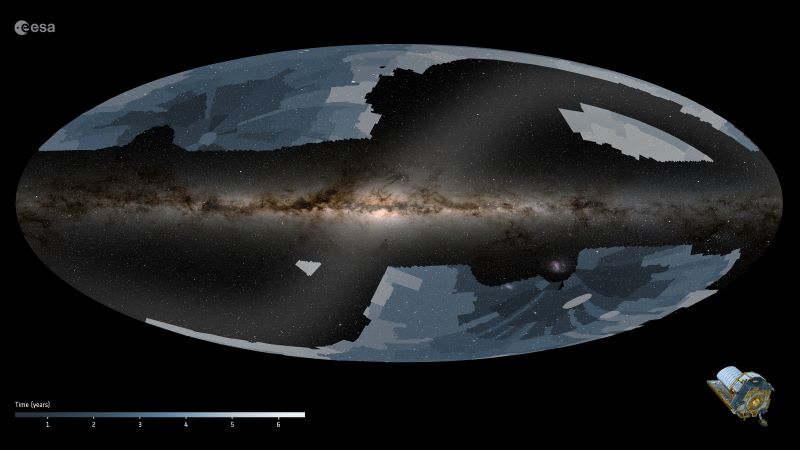Now Reading: Scientists reveal largest universe simulation yet produced
-
01
Scientists reveal largest universe simulation yet produced
Scientists reveal largest universe simulation yet produced


Scientists have unveiled the largest simulation of our universe ever created. The Euclid Consortium released it to the public on September 22, 2025. The cosmological map contains 3.4 billion galaxies, each intricately modeled to include over 400 different known and possible properties.
Combined, these galaxies outline the cosmic web – thought to be our universe’s skeleton, dominated by dark matter – a giant scaffolding on which galaxies form and evolve.
The simulated universe is known as the Flagship 2 galaxy mock. It’s designed to simulate the data the Euclid space telescope will have captured when it completes its 6-year night sky survey in 2030.
Astronomers are using this galaxy catalog to prepare their methods of analyzing the colossal dataset Euclid is collecting. And now, the catalog is freely available to the scientific community and the wider public.
A team of eight European institutions within the Euclid Consortium developed the simulation, led by the Institute of Space Sciences (ICE-CSIC) and the Port d’Informació Científica (PIC) in Barcelona.
The researchers first detailed the simulation in a peer-reviewed paper in the journal Astronomy and Astrophysics on April 30, 2025. And on September 22, 2025, the Euclid Consortium announced that the data is now publicly available on the CosmoHub platform.
How to simulate a universe
This simulation isn’t a map of the actual universe we know. Instead, it’s a fabricated mini-universe, generated according to our best knowledge of the physical laws that govern everything around us. So it doesn’t exactly resemble the layout of our universe up close, but it’s statistically similar to our universe when you zoom out.
So how do you construct a realistic universe? The first step was using a supercomputer to simulate the gravitational interactions of 4 trillion particles. These particles served as dark matter: the mysterious, invisible substance thought to make up 85% of the mass in the universe.
At the birth of the universe, matter was fairly evenly distributed. But there were some wrinkles of slightly higher density. And scientists generally believe these wrinkles caused dark matter to clump together, eventually forming great cosmic blobs known as dark matter haloes. And, sure enough, having simulated the interactions of the 4 trillion particles, the researchers identified 16 billion clumps resembling these haloes.
Scientists think dark matter haloes played a crucial role in the early universe. They provided gravitational wells where material could clump together to form stars and galaxies. So the next step was to place galaxies into these simulated haloes.
Just add galaxies
Using actual sky surveys of real galaxies, the researchers developed statistical rules about how many galaxies typically exist in haloes of different sizes, and what these galaxies look like.
Then, they used this algorithm to populate their dark matter universe with a realistic array of galaxies. They fine-tuned each galaxy through over 400 different parameters, such as brightness, velocity, shape and spin.
Pablo Fosalba, one of the scientists behind the simulation, explained:
The main value of the Flagship catalog is its comprehensive set of properties that have been derived per galaxy. We have checked that many of these properties closely resemble what we see in observational data, but we are just starting to explore how far we can go in terms of predicting properties that future galaxy surveys will observe in great detail.
So while the simulation matches what we’ve seen in the universe so far, the real test is how well it aligns with future galaxy surveys, like that of Euclid.

What’s the universe simulation for?
The purpose of this universe simulation is to help scientists interpret the findings of Euclid. Built by the European Space Agency, Euclid launched in July 2023. And in February 2024, it began a six-year survey of 1/3 of the night sky. Scientists hope this survey will provide key insights into the nature of dark matter and dark energy. It should help astronomers better understand the universe’s expansion and structure over time.
Euclid can image up to 50,000 galaxies in a single shot. So the spacecraft’s six years of observations should provide an enormous amount of data for scientists to sort through. And that’s where the new universe simulation comes in.
The Flagship 2 galaxy mock provides scientists a virtual laboratory to test how they will process and interpret the data Euclid collects. The simulation is “crucial for preparing the analysis of Euclid’s data,” Julian Adamek of the University of Zurich explained.
A universe simulation is never finished
As new data from Euclid comes in, scientists will update the simulation’s parameters to closer resemble reality. And there’s certainly room for surprises. The simulation is based upon our best guess as to the nature of dark matter and dark energy. And this has become increasingly contested in recent years. Adamek said:
We already see indications of cracks in the standard model. It will be exciting to see whether the model holds up against Euclid’s high-precision data, or whether we uncover signs of new shortcomings.
Bottom line: Astronomers have unveiled the largest universe simulation ever created. It’s designed to help scientists prepare for the data the Euclid space telescope is collecting.
Source: The Flagship galaxy mock catalogue: A comprehensive simulation for the Euclid mission
Read more: New Euclid images reveal hidden gravitational lenses
The post Scientists reveal largest universe simulation yet produced first appeared on EarthSky.
Stay Informed With the Latest & Most Important News
Previous Post
Next Post
-
 012024 in Review: Highlights from NASA in Silicon Valley
012024 in Review: Highlights from NASA in Silicon Valley -
 02Panasonic Leica Summilux DG 15mm f/1.7 ASPH review
02Panasonic Leica Summilux DG 15mm f/1.7 ASPH review -
 03How New NASA, India Earth Satellite NISAR Will See Earth
03How New NASA, India Earth Satellite NISAR Will See Earth -
 04And Thus Begins A New Year For Life On Earth
04And Thus Begins A New Year For Life On Earth -
 05Astronomy Activation Ambassadors: A New Era
05Astronomy Activation Ambassadors: A New Era -
06SpaceX launch surge helps set new global launch record in 2024
-
 07Space Force plans new ‘Futures Command’ amid pressure to speed up modernization
07Space Force plans new ‘Futures Command’ amid pressure to speed up modernization




















